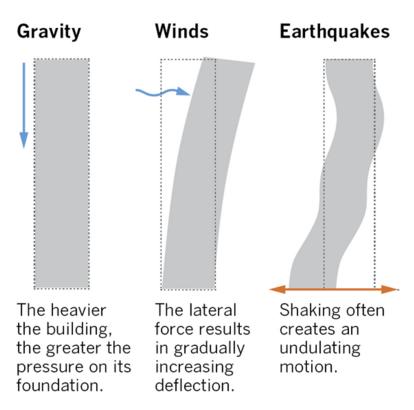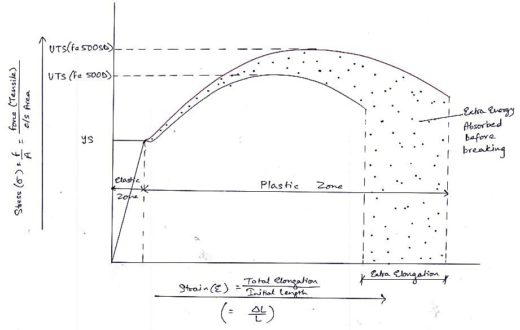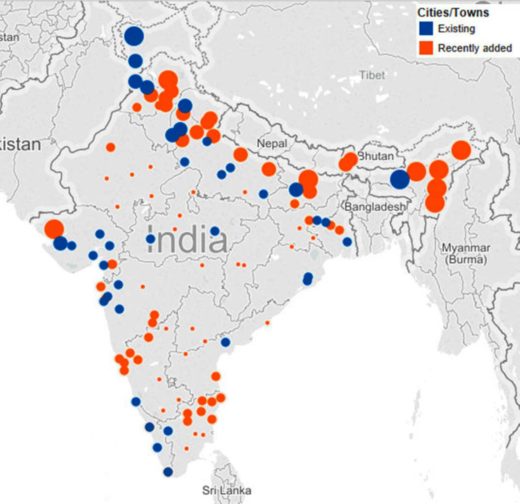By
Priyanka Gupta
1.0 Introduction
In April 2016, 81 new towns and cities were added to a list of areas prone to earthquakes, bringing the total to 107. In 2012, BIS has introduced special earthquake resistant steel in India standard 1786 for HYSD bars. But this still needs a mention in design code of IS 456 for design help. There are few manufacturers in India which make earthquake resistant steel with grade name as Fe 500 SD which can be used in seismic resistant designed buildings.
| Zone | Intensity |
| II | Less than equal to 4 |
| III | 7 |
| IV | 8 |
| V | More than or equal to 10 |
| Note:Intensity measured in ‘Modified Mercalli Scale’ | |
Seismic Zones In India
The Bureau of Indian Standard has grouped the country into four seismic zones
Intensity of earthquakes in different zones
| Seismic Zone | Intensity on Modified Mecalli Scale | Areas |
| Zone V
(Very severe intensity zone) |
IX (and above) | Entire northeastern India, parts of Jammu and Kashmir, Himachal Pradesh, Uttaranchal, Rann of Kutch in Gujarat, parts of North Bihar and Andaman & Nicobar Islands. |
| Zone IV
(Severe intensity zone) |
VIII | The remaining parts of Jammu & Kashmir and Himachal Pradesh, Union Territory of Delhi, Sikkim, northern parts of Uttar Pradesh, Bihar and West Bengal, parts of Gujarat and small portions of Maharashtra near the west coast and Rajasthan.
|
| Zone III
(Moderate intensity zone)
|
VII | Kerala, Goa, Lakshadweep islands, and remaining parts of Uttar Pradesh, Gujarat and West Bengal, parts of Punjab, Rajasthan, Madhya Pradesh, Bihar, Jharkhand, Chhattisgarh, Maharashtra, Orissa, Andhra Pradesh, Tamilnadu and Karnataka.
|
| Zone II
(Low intensity zone) |
VI (or less) | The remaining parts of the country. |
2.0 Seismic Force and its nature

While the gravitational forces (dead weights, moving weights, weight from temporary structures) act downward, the wind forces act horizontal across the height of a structure. The seismic (or earthquake) forces are nothing but horizontal motion of the ground and it acts only at the base of a structure. Moreover while gravitational and wind forces are continuous (with respect to time) seismic forces are momentary and lapse only few milliseconds. Also the aftershocks of the earthquake act on the building on and off for several days.
3.0 Stiffness, Ductility& Tensile Testing
By definition Stiffness (k) = Force / Displacement
![]()
Hence ductility will be inverse of stiffness i.e. 1/ k.
So Ductility is the amount of elongation for a unit increase in force.
A RCC structure can be made ductile in two ways:
1. By doing ductile design and detailing – In local and remote places the expertise is not available
2. By using ductile material – Concrete and brick cannot be ductile, hence only reinforcement can be ductile.
The rebars available in Indian market are ductile steel with elongation percentage of 12% and utilization ratio of 1.12. There is a new grade of steel which has elongation percentage of 18% and utilization ratio of 1.15. This new grade is called Super Ductile.
The properties of a super ductile thermo-mechanically treated rebar are as follows:
| Parameter | Fe 500D
(Ductile) |
Fe 500SD
(Super Ductile) |
BS 4449
500B |
BS4449
500C |
AUS / NZ
500N |
AUS / NZ
500E |
| Yield Stress (in MPa) | 500 | 500 | 500 | 500 | 500 | 500 |
| Ultimate Tensile Stress (in MPa) | 560 | 575 | 650 | 650 | 650 | 600 |
| Utilization Ratio (UTS / YS) |
1.12 | 1.15 | 1.08 | 1.15 | 1.08 | 1.15 |
| Total Elongation (in %) | 12 | 18 | 5 | 7.5 | 5 | 10 |
A brief definition of all the terms defining the mechanical properties of rebars:
YS – (Yield Stress) is the stress at which a 0.2% of plastic deformation is produced in steel rebar in tension.
UTS – (Ultimate Tensile Stress) is the maximum amount of stress sustained by a rebar in a tensile test before rupture.
Utilization ratio is the ratio of UTS and YS.
% Elongation is the ratio of total elongation of rebar and its original length expressed in percentage.
Utilization ratio and % Elongation together gives an estimate of amount of energy absorbed by the rebar specimen in a tensile strength before failure. (This is clear in the graph below)
While in Limit State and Working stress design methods, the strength of the steel guides the main reinforcement and its consumption, the ductility of reinforcement is important in calculating the shear bearing capacity of the structure. IS 13920 clearly specifies for ductile design, the elongation of rebar should be 14.5% and confirming to IS 1786.
GENERAL SPECIFICATION
The design and, construction of reinforced concrete buildings shall be governed by the provisions of IS 456 : 1978, except as modified by the provisions of this code.
For all buildings which are more than 3 storeys in height, the minimum grade of concrete shall be M20 (fcL = 20 MPa).
Steel reinforcements of grade Fe 415 (see IS 1786 : 1985) or less only shall be used.
However, high strength deformed steel bars, produced by the thermo-mechanical treatment process, of grades Fe 500 and Fe 550, having elongation more than 14.5 percent and conforming to other requirements of IS 1786 : 1985 may also be used for the reinforcement.

Characteristic curve for Fe 500D & Fe 500SD grade of rebar (during tensile testing)
For details of tensile testing one can refer to:
IS: 1608 Mechanical Testing of Metals – Tensile Testing
IS: 1786 High Strength Steel Bars and Wires for Concrete Reinforcement – Specification
We at engineeringcivil.com are thankful to Er Priyanka Gupta for submitting this very important paper to us.
If you have a query, you can ask a question here.




Madam,
can we get experimental details and stress strain curve for ductile bars i.e Fe 500 Fe 500D Fe500SD
regards